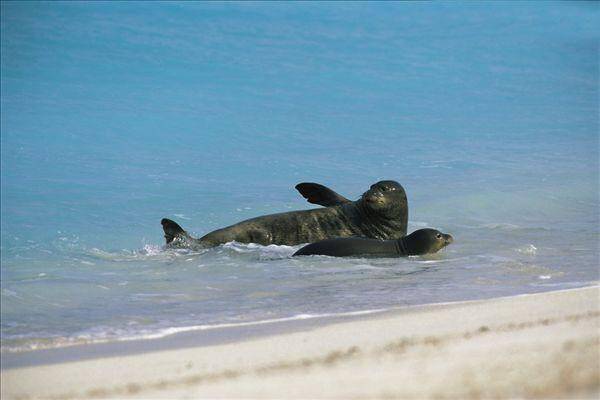Monachus schauinslandi
IUCN
LCBasic Information
Scientific classification
- name:Monachus schauinslandi
- Scientific Name:Monachus schauinslandi,Hawaiian monk seal
- Outline:Carnivora
- Family:Phocaea P.subfamily P.genus
Vital signs
- length:2.1-2.25m
- Weight:169-203kg
- lifetime:10-30years
Feature
The head is very round and covered with short, dense hair, which looks like a monk's head.
Distribution and Habitat
It is only distributed in the Hawaiian Islands in the central and eastern Pacific Ocean.
There are six main populations: Kure Atoll Island in the northwest of Hawaii Island, Midway Island, Pearl Harbor Hermes Reef, Lisasco Island, Laysan Island and French Frigate Shoals.
Appearance
The head of an adult seal is very round and covered with fine short hair, which looks like a monk's head, hence the name. The snout is bulging and protruding, and the whiskers are smooth, straight and soft. The distance between the left and right nostrils is wide. The body is dark brown or chestnut, with dark hair on the back and slightly lighter on the ventral side, without stripes. The back of the palate is V-shaped, with 32 teeth and wide cheek teeth. The female body is slightly longer. The snout is wide, with sparse straight and soft tentacles around the mouth. The distance between the left and right external nostrils is wide, with a straight groove in the middle. The hair is sparse. The young are covered with black soft hair, which falls off at the end of the lactation period. The claws on the forelimbs are well developed, the claws on the hind limbs are degenerate, and the outer toes are the longest. The average length of an adult male is 2.1 meters and the weight is 169 kil
Details
Hawaiian monk seal (scientific name: Monachus schauinslandi) is the only native seal in Hawaii.

Except for the breeding season, Hawaiian monk seals usually live alone and occasionally in small groups. They are active at night, spend a lot of time foraging at sea, and return to the shore to sleep after a full meal. Usually, the activity area is close to the island where they were born, and only 10% of monk seals migrate to other islands. Like other pinnipeds, Hawaiian monk seals do not have the ability to rotate their hind flippers, so they use their front flippers to move on land, but they are very agile in the water and can control their spindle-shaped bodies freely with their flippers.
Hawaiian monk seals do not migrate over a large area, usually hunting on coral reef slopes at a depth of 75 to 90 meters. They can dive for 5 to 14 minutes and dive to a maximum depth of 500 meters. They feed on fish and cephalopods such as eels, flounders, octopuses, lobsters, and naked eels.
The mating period of Hawaiian monk seals is very long, starting in March, with a peak period from April to May and ending in August. They mate once a year and give birth to one baby. The breeding grounds are on the Leeward Islands of the Hawaiian Islands. The gestation period of females is 11 months, including a 3-month delayed implantation period. When giving birth, females leave the ocean and look for the nearest breeding site on the beach. The cubs weigh 14 to 17 kilograms at birth and weigh about 50 to 100 kilograms after weaning. The lactation period is 5 to 6 weeks. When weaning, the females suddenly abandon the cubs and return to the sea, waiting for 3 to 4 weeks before entering the mating period again. Hawaiian monk seals are one of the three pinnipeds that raise their offspring (the other two are gray seals and northern elephant seals). Females are very patient in raising their cubs. When they are separated by a distance, they will always follow the cubs. Both sexes reach sexual maturity at the age of 5 to 10 years old. If pups are weaned at a higher weight, they usually have a better chance of survival and reach sexual maturity earlier.
The abundance of Hawaiian monk seals was estimated at 1,488 in 1983, a 37% decrease from the 2007 figure. Since 1999, the population has been declining at a rate of 4.1% per year. In the past, humans hunted Hawaiian monk seals for meat, fur, and oil. In the 21st century, the activities of humans and domestic dogs on these islands and atolls have forced Hawaiian monk seals to move away from their preferred habitats. Although the species is currently protected, its population is declining due to lack of food resources, entanglement in marine debris and fishing gear, and predation by sharks. In addition, global warming, rising sea levels, and acidification of coral reefs continue to threaten their survival. Further efforts are needed to reduce the interaction between humans and Hawaiian monk seals on the main inhabited Hawaiian Islands. Relevant departments are considering controlling the ecosystem of the northwest Hawaiian Islands to make it more suitable for Hawaiian monk seals.
Listed in Appendix I of the Convention on International Trade in Endangered Species of Wild Fauna and Flora (CITES).
It was approved as a Class 2 protected aquatic wildlife in China on October 9, 2018.
Listed in the 2008 Red List of Endangered Species of the World Conservation Union (IUCN) ver 3.1 - Critically Endangered Species (CR).
Protect wild animals and stop eating game.
Maintaining ecological balance is everyone's responsibility!








